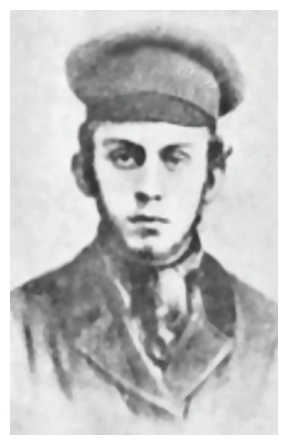
|
by M. N.
In the middle of the market in Radomsk stood a house, which belonged to Reb
Mordekhai Szpira. This house possessed a peculiar emblem on the front wall – a
head of a chimneysweep, with beads on the throat. This was bricked in the
middle of the house, very near the roof.
A verse went around that the emblem was a conspiratorial sign for the Polish rebels of 1863. That the rebels' room is located in the house and there the conspirators' conferences were held.
Mordekhai Szpira was a Jew, a rich man, a Gerer Hasid, a man burdened with thirteen children. He and his wife Hana had a spice shop in the house and later an iron store.
 |
| H. D. Nomberg |
When the children had grown little by little, Reb Mordekhai began to look for a
husband for his oldest daughter Mashele, who was then sixteen years old. He
traveled, as was his habit, twice a year on yom-tov to Ger to the rebbes.
Sitting by the rebbes in Ger, Reb Mordekhai asked for a young man as a
husband for his oldest daughter. He was ready to take the son-in-law “oif kest”
(Translator's note: provide room and board) instead of giving a dowry.
After three years, after deliberation, the rebbe gave his advice: in as much as
there is a yeshiva in Radomsk proper, he should turn to the head of the
yeshiva in his name and he would, according to his opinion, make an
effort to find an appropriate young man among his students.
Coming home after the holiday, with a document from the rebbe attesting to his lineage in his pocket, Reb Mordekhai turned to the Radomsker head of the yeshiva, Reb Mendel, with a plea that he choose a young man for him from a good family, chiefly a Talmudic student. The yeshiva head promised to give an answer in about a week. A week later the head of the yeshiva proposed a candidate for son-in-law to Reb Mordekhai – the child prodigy Hersh-Dovid Nomberg, a young man, an orphan (Translator's note: in Yiddish, a child whose father had died is considered an orphan), who came from Amszinow (Mszczonow in Polish).
Reb Mordekhai did not oppose the choice, but he asked the head of the yeshiva to send the young man on the nearest Shabbos, after noon, to an “audition.” At the appointed hour, the young man accompanied by Reb Mendel came to Reb Mordekhai's room. [Reb Mordekhai] had invited to the “audition” every Gerer Hasid with whom he was acquainted. The twenty pages of Gemera, which the young man had learned by heart, made a colossal impression. The “audition'” ended with the general wisdom that the young man has an “open head'” and is, indeed, the prodigy of the yeshiva.
Reb Mordekhai agreed to the choice and proposed to Reb Mendel that he should inform the mother of the young man and discuss the terms of the tanaim (engagement contract), although the groom and the bride did not know each other. Later it was announced and the tanaim was written and the wedding was set for about three months hence.
All of the Gerer Hasidim of the city were invited to the wedding along with the head of the yeshiva and all of the students and many acquaintances and guests. Before the khupe, the bride's mother showed her daughter Mashele her groom and Hersh-Dovid looked at his bride for the first time. The wedding celebration lasted for eight days as was then the custom and took place with great pageantry. After the wedding, Hersh-Dovid returned to studying and spent time together with his friends in the Beis Hamidrish until late into the night.
The three promised years of kest quickly ended. Reb Mordekhai began to think about a business for the young pair, who at that time already had two sons – Moishe and Eliezer. He rented a store for them, together with an apartment – a food store. Hersh-Dovid had to interrupt his studies and remain at home, in order to help his wife serve the customers. For almost a whole day, no one was seen in the store. When a customer did appear, Reb Hersh-Dovid would interrupt his studies and serve the customer with a melody from the Gemera… Very often it happened that Hersh-Dovid would confuse things. Instead of giving what was asked for, he gave another product.
Hersh-Dovid began little by little to abandon his studies and from time to time, began inviting his friends Sz. Y. Epsztajn (Kakeske ) and Abraham-Yakob Tiberg for “sixty-six” (a card game). Guarding himself from his contentious wife, he began to read various “not-permitted” books in the Hebrew and Yiddish language. When Reb Mordekhai learned about Hersh-Dovid's behavior he began to howl: “It denotes – such a heretic!” The moralizing and curses did not help. It was decided to close the store.
Hersh-Dovid traveled to Warsaw and, in order to support himself there, gave
lessons in the Hebrew language. The income from this was negligible and
Hersh-Dovid had to return to Radomsk. He was already then totally different,
not the Hersh-Dovid of before.
[Page 275]
He started to study languages by himself and mastered them in a very short time.
Gradually, he started to write songs, short stories and random stories, which
he sent to the editors of Hebrew newspapers in Warsaw. (Hazman [“The Time”],
Haboker [“The Morning”], and later Hatzfirah [“The Siren”]).
All of the material he sent was recognized by the editors as artistic creations
and were published without revisions.
After a conflict with Reb Mordekhai, who had demanded a get (religious divorce) for his daughter from Hersh-Dovid, he [Hersh-Dovid] decided to leave Radomsk and travel to Warsaw to seek success for the second time. This time he was satisfied, because his songs and short stories were published in the Warsaw newspapers. He turned, as was then the custom of the young Jewish writers, to Y. L. Peretz, of blessed memory, who took him on with open arms and fought with him for beginning to write in Yiddish.
After speaking with Y. L. Peretz, Hersh-Dovid Nomberg was taken in as a permanent contributor to the daily newspaper “Heint” (Today).
In 1909, the editor of “Heint ” delegated H. D. Nomberg to go to America. Before departing, he suddenly came to Radomsk to see Mashele and the children. He boarded in the furnished rooms of Mr. Winter and in the morning sent a messenger to Mashele to inform her that he had come from Warsaw and wanted to meet with her and the children. The meeting took place in Shlomele Epsztajn's home in the presence of the oldest son Moishe. All three sat and were silent. Suddenly, Hersh-Dovid stood up from his place, came to Mashele and proposed to her that she travel with him to America and there get married again. The three children would have to be left temporarily in Radomsk, until he would be settled [in America]. Mashele listened to the proposal and asked to postpone her answer until the next morning.
The next evening, during the second meeting, Mashele rejected the proposal, [giving as] the reason that her father, Reb Mordekhai would not agree to keep the children with him and he would certainly renounce his daughter, if she would travel with the “heretic'” Hersh-Dovid to America.
At his departure, Hersh-Dovid asked that she agree to take a photograph together with the children. She agreed that the photograph would be taken without her, only he with the children. Such a photograph was taken, in Wajnberg's studio* (in the market).
After that encounter, Hersh-Dovid never again visited Radomsk. Reb Mordekhai Szpira took his daughter and her children into his house and took pains to raise them as frume (religious) Jews, in his spirit. When the children had grown up, one by one they left Radomsk and settled down with the assistance of their father in Warsaw.
*Printed in this book on page 65.
During the outbreak of the Second World War, Mashele lived in Radomsk. When the Germans erected the ghetto on Shul Street, Mashele was driven to the ghetto with the large Szpira family.
Later she wound her way out from the ghetto and traveled to Dombrowa-Gurnicza, where her son, Kalman Wohlhendler, from her second husband (He was a ritual slaughterer) lived. She arrived safely, but during the liquidation of this ghetto (1943) she and all of the Jews from Dombrowa-Gurnicza perished.
Of all three sons of H. D. Nomberg, only the oldest Moishe survived. He is now
with his family in Israel.
H. D. Nomberg
Oy-Vey and Eh, Eh, Eh, Oy, Oy
a.
A hurt in the person's life,
Oy yes! It is so.
He chases good fortune and finds it nearby
And chases and falls, oy, oy!
Eh, eh he chases and runs!
Oy-vey, good fortune runs away!
The time
Passes!
Alone
Remains standing
The man and sees: the head is gray
He asks first: “What is the purpose?”
And laughs with malice: “The end of playing!”
Oy-vey
b.
The world is foolish and corrupt,
Oy yes! It is so.
She had acquired many belongings
And needs – still more, oy, oy!
Eh, eh! The money succeeds!
Oy-vey! The need crushes!
And curses
The world
With blows
And bundles
And thinks hereby we quiet thus:
And we hit the world in the head and turn.
Remains a calm heart! They clearly understand!
Oy-vey and eh, eh, eh, oy, oy!
c.
My daughter is a song of songs.
Oy yes! It is so.
Good luck.
She kisses
Refreshes,
Her gentleness is morning dew,
Then she plays now on another's lap!
They are calm, heart, and scoff at you!
A Travel SongBlack clouds run, chase,
The wind whistles and roars,
Your father sends from Siberia
To you a greeting my child!Only the wind.
He brings us greetings
From the cold land!There it stands, a spade
He holds it in the hand.
And he digs everything deeper, deeper,
Throws the earth out –
Do not worry then!
For a falsehood
He digs out graves.Not the first, not the last
He falls on the field!
Do not worry my child, gave birth to you
Did a great hero.And a hero you will grow to be,
Sleep, sleep now:
Gather strength for the future.
Gather strength for the future,
Gather, only child!
by Zeeva & Dvora
Translated by Hadas Eyal
On the first yahrzeit of Radomsker David Kalay, a compilation of texts was put
together by Tversky Publications in his memory. This is the forward by Avraham
Levinson.
During the 29 years he lived in Israel, David Kalay never stopped writing. His many articles on various aspects of life – society, economy, settlement, culture, etc. – were published in each and every labor press outlet. Many but not all are gathered in this collection. This 400-page book has eight sections of texts written about him, by him, and to him, as well as a 200-item bibliography of his books, translations and articles.
From the collection, we bring you here the words of his daughter Zeeva and
sister Dvora.
| The Editorial Staff |
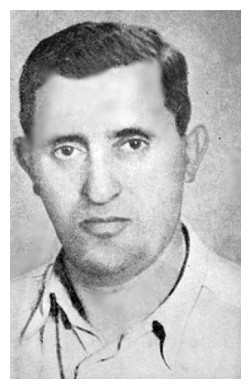 |
| David Kalay (Gold)
1898 - 1948 |
Father was born in the southern Polish town of Szczekociny to a religious
orthodox family. His family moved and settled in Radomsk where he lived most of
his childhood and adolescence and it is where he began his public service work.
David adored and admired his older brother who was a rebel known for reading prohibited secular books. Under his influence, David learned to read many languages and would secretly visit general libraries. At age 13 he found his way to Mendel Frenkel. In a letter David writes: “At Frenkel's house when I was 13 years old I devoured the book 'Each Generation and its Scholars' [Dor-dor ve dorshav by Isaac Hirsch Weiss] but by then I already had scores of books from the world of new literature”.
That year father was accepted into the high class at the Yeshiva of the Gur Rabbi and left to study there. He is welcomed into the rich libraries of the Rabbi and the Rabbi's brother where he is soon appointed librarian. This is also when he begins to write. His articles on yeshiva life and youth are published in the Charedi newspaper “HaPeles” and the daily newspaper “DerMament” and he becomes an activist in the local youth literature and cultural association. When he published a column criticizing the yeshiva – a considerable sin – he is dispelled.
Father returns to Radomsk feeling the need to advance his secular general knowledge. He studied on his own for a year and passed five exams at the Russian-Polish secondary school. During that time, he also began translating stories by Gorki to Hebrew and Yiddish.
He took his first steps in cultural-educational work alongside his older brother Nachman. At age 17 he was the “Cultura” society librarian, lecturer and activist. At 18 he was among the founding members of the Radomsk Zionist Association as well as its secretary and librarian while also a founding member and senior councilor of the movement “Agudat haShomer”.
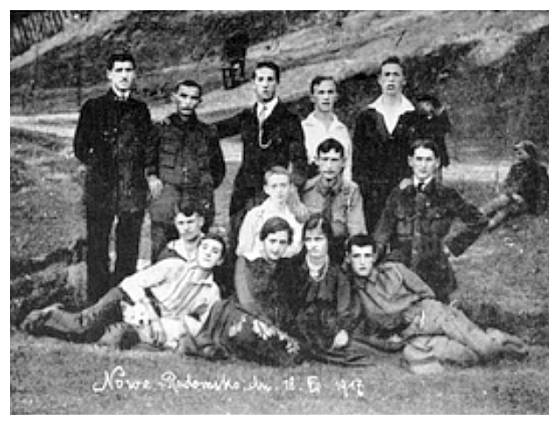 |
| Agudat haShomer, 1917 |
In 1918 father moved to Warsaw. He attends psychology and sociology classes at
the Society of Science Courses (Towarzystwo Kursów Naukowych) – a
free university of prominent Polish scholars who refused to take part in the
official university of the German conqueror. In Warsaw father finds his place
in the circles of Jewish society and the Zionist Youth, helping establish the
Polish Tseirei-Zion movement and its weekly journal Liberation. Fulfilling a
childhood dream he worked for 6 months on the editorial board of the Zfira
newspaper where his brother used to work years before. He even trained as a
printer and considered it as his future livelihood.
At the beginning of the 3rd Aliya in 1920, father joins his close friends and they arrive in Eretz Israel. He often told me how sorry he was that his fate did not make him a simple farmer, worker, manual laborer or printer. From a young age the fields he plowed were those of cultural community work. Cultural cultivation is what he continued to do in Israel. Immediately after arriving he began working on the editorial board of the Contras. Not the manual labor in the gravel of roads as the majority of the members of the 3rd Halutz Aliya but directly to the editorial board where he writes articles and for a time manages the book publication company of Achdut-HaAvoda.
In 1921 the labor community begins to form the General Organization of Workers in Israel [haHistadrut haKlalit shel haOvdim beIsrael]. Father – one of the “newbies” – was an organizer and activist. Although not an elected delegate he was nonetheless among the Organization's founders. In his journal he wrote: “I have only been in Israel for six months. I have gotten to know many locals and many who came here from various diasporas. I have only been to Tel-Aviv-Jaffa, Jerusalem, Petach Tikva and Haifa so far. I found people with heart and soul. Throughout my busy public work, I have seen only willingness from others, Israel is undoubtedly a necessary place and has the best earth for developing the spirit of our young people” (1921).
Also in his journals from that year:” Wandering through Nes-Ziona, Beer-Yaakov, Tsrifin, Rehovot, Yavne and Rishon-LeTsion. It is wonderful. Walking towards horizons of sky and land one feels the Shechina [divine spirit]; everything shines, warms, encourages, excites, lifts” (1921).
Father felt strongly from the start that in order to become socially educated
and broaden their horizons – the workers required educational material.
This realization was the center of everything he did in Israel from then on. He
always said: foundations, sources and traditions are the most important”.
From this viewpoint, he set out to translate the Communist Manifesto. Despite
his concern that it was beyond his abilities, the necessity drove him forward
and the project was completed. He was 24 years old.
[Page 278]
A more sophisticated translation of the Communist Manifesto was published 27
years later by the Kibbutz HaMeuchad but father has and will always have this
first right credit for his translation when labor literature was virtually
scarce and printing options were miniscule. His green booklet did its job
during those years. Thousands of workers and youth used it to form a solid base
of socialist ideological consciousness.
In 1921 construction of first workers' neighborhood 'Borochov' began near Tel-Aviv and father was of the first founders and a member of its statute draft team. He happily wrote his brother about his first night in the temporary shed on his land. He remained in the neighborhood to his last day, directly active as chair of the general assemblies or behind the scenes with practical suggestions on all aspects. In difficult times when the neighborhood digressed from its initial Halutz ideology father did his best to fend against these threats. Borochov veterans know what Kalay was for the neighborhood and what it was to him.
In the years 1923-1929 father was the director of the central library of the General Organization of Workers and managed the book publications of its cultural committee. From 1925 he edited and published a social studies library named after Zeev Barzilay. Here as well, he stuck with his guiding principle: instilling the basics through introductory learning materials – source material. For this library he translates Ferdinand Lascelles's “A Program for Workers”; writes “The First of May”; and translates the large five-part book by Max Beer “The General History of Socialism and Social Struggle”.
As a member of the central culture committee of the General Organization of Workers and during that time father drafted the first statute its employees who at that time included kindergarten and school teachers (later renamed the education center).
His writing, editing and publishing work continued with social science books including “England” by Wilhelm Dibelius written in 1930 and “Capitalism & Socialism After the World War” by Otto Bauer. Working on the translation of these books, father created many new Hebrew words that were not available in those days for terms (especially economic expressions) to avoid using too many foreign expressions.
Some of these words were not adopted into spoken Hebrew, for some better adaptations were created over time, but many of his inventions did blend into the Hebrew language. Examples are Hebrew words for production (יצור); displaced and disinherited people (עקורים ומנושלים); agitator (תעמלן); economist (כלכלן); supplier (ספק); transport (תחבורה) and many more.
In 1927 father began formulating a bold dream to translate the iconic book “Das Capital” by Karl Marx into Hebrew. Many questions had to be taken into account. Who should it be translated for? Who will publish it? Who will pay for the expenses? If he would have successfully found answers to these questions, “Das Capital” would have been published by 1929. But by then father had a family to support and he was well aware that without a contract with a serious publication company he would not be able to take on responsibility for such a project. Unfortunately, negotiations with “Sifriat Hapoalim” [“Workers Library”] fell through and the book was translated by others. Despite his great sadness, he was truly happy once the book was published. We at home felt his mixed feelings well.
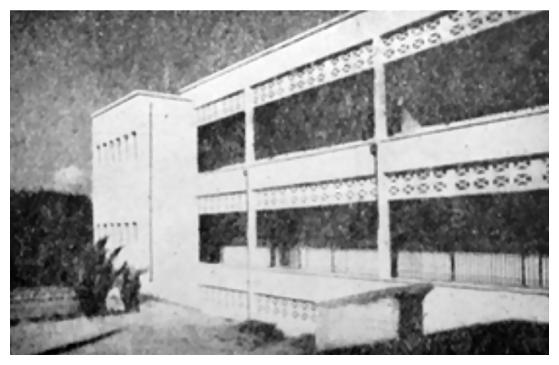 |
| David Kalay High School in the city of Givataim |
In 1930 the cultural committee was dismantled and father moved on to editor
positions in major commercial publication companies where he was able to
execute another dream: to edit and publish a general encyclopedia in Hebrew. He
actually edited two encyclopedias – Masada General Encyclopedia and the
Youth Encyclopedia that was part translated from foreign encyclopedias and part
original and relevant to Israeli youth. Father never published anything without
studying and understanding it first, checking each item, each fact.
He returned to the General Organization of Workers in 1945. As manager of the archives he had broad freedom. One of his major goals was to gather the large amount of high quality historical records that was confiscated from Jewish immigrants who illegally sailed to Israel from Europe during the British mandate and were deported to Cyprus where the documents were left. It was his personal mission to bring these documents to Israel and he travelled twice to Cyprus for this purpose, fearing the documents would soon be destroyed. He returned with crates filled with material of great historical, national, ideological and archival importance.
On Rosh HaShana 1948 father and mother came to celebrate with us at Kibbutz Beit HaShita. Father was excited to take a break from work and travel. We walked for three hours just father and I. I loved and missed our talks about politics, the labor movement, literature and his plans. Three precious hours of leisurely conversation and strolling along and I did not know those were my last hours with my father…
Unfortunately, he did not live to fulfill many of his plans.
| Zeeva |
| [David Kalay's daughter] |
With a broken aching heart, I will tell you about my brother David Kalay and
the house we grew up in. Our father, Yaacov Mordechai Gold was considered a
torah prodigy. He received his rabbinical certification from the Genius Rabbi
of Metow when he was 17. He studied languages, literature, and was a devout
follower of the Gur Chasidut and the 'Sfat Emet' book by Gur leader Rabbi
Yehuda Aryeh Leib Alter.
This was the atmosphere in which the sweet wonderful boy David grew up. At age 5 he was already knowledgeable on the Chumash. I remember well how my mother, a noble woman, would get the young boy out of bed each morning at 5am and dress him. She held his hand and a tea kettle for the Melamed Rabbi in her other hand. David, shiny-eyed, always took the wood torch he made himself, lit the candle in it, took his mother's hand and left the house singing a merry Jewish folk song on his way to the Cheder.
By the time he was 12 there was no qualified Rabbi in Radomsk who could teach him because David knew more than anyone in town. He was therefore sent to the Gur Yeshiva without disclosing his young age because students were only accepted after their bar-mitzvah. He amazed the Yeshiva managers and within a few months he was moved to the highest class. David's idyllic education at Gur lasted approximately two years until our family was informed by telegram that he escaped the Yeshiva and headed to Warsaw.
My father and older brother quickly travelled to Warsaw to look for him. When found, he told them that a published satirical newspaper article that he wrote ridiculing the Gur Yeshiva was found in his suitcase during a search. Fearing the disgrace of severe punishment, he fled to Warsaw. Thus, at age 14, began David's writing career, his calling and passion for many decades until bitter fate wrenched the pen out of his hand far too early.
David did not return to Gur, of course. He stayed at our parents' house and took up general studies and public activism. He organized a scouts' youth movement, established libraries, and was one of the founders of the Radomsk Tseirei-Zion.
At the end of WWI, David moved to Warsaw during its struggle for its freedom. In 1920 he found a window of opportunity and made Aliya to Israel.
| Dvora Carmelit (Gold) |
| [David Kalay's sister] |
by Shlomo Tanai
Translated by Hadas Eyal
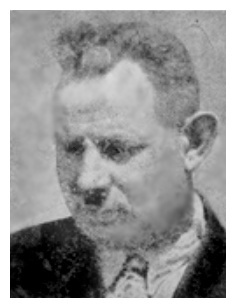
1887-1942
Khanina-Yosef was the first of the extended family to actually be exposed
western culture. During his youth he studied in the city of Katowice in Upper
Silesian. He married Esther-Pearl Buchner when he was 19. As an adult he became
an enthusiastic Zionist activist, ensuring his sons receive a Hebrew and
Zionist education. He loved music and literature and passed his passion on to
his children. It was told that when he met mother he bought her classic German
books, one of the reasons the family “banished” him. He also took
violin lessons.
[Page 281]
The house was always open to guests and welcomed Zionists and Chalutsim. In
November 1929, just after the pogroms and shortly after his eldest son made
Aliya, Khanina-Yosef sold his businesses in Poland and moved the entire family
to Israel – five boys and three girls (one of them was already married).
After an initial adjustment period the family put down roots and changed their
family name to Tanai.
Father travelled to Poland every so often. WWII irrupted during his last visit in 1939. The family maintained contact and attempted to arrange an escape but when Italy entered the war in 1941 it became clear they would not be able to save him. When the war was over we were notified that father perished in the great Shoah.
People who met him before his last journey told us that he refused an option of escape for two reasons. The first was that he was no longer young and he worried that if he dies on the way he would not be brought to Jewish burial. Secondly, his help was needed and he did not want to abandon the community during the difficult days.
We received a Chai prayer in his handwriting along with various documents through a survivor who received them from father before his last journey.
May his soul be bound in the bundle of life.
Editor's note: The entry above by Shlomo Tanai (Koshitzki) and the lines of the Chai prayer to follow by his father Khanina-Yosef Koshitzki are from a booklet printed by Shlomo Tanai and published in Tel-Aviv in 1950. The booklet also includes a prayer Khanina-Yosef Koshitzki wrote in memory of his father; a last blessing to his mother; an earlier Chay prayer, in rhyme, each initial letter in the sentence forming the names of all members of the family: Khanina-Yosef, Esther-Pearl, Elimelech, Tamar, Ohad, Rani, Avraham, Mary, Shendel, Isaschar-Dov, Ruth, Eliezer, Malka, Rachel, Shlomit, Moshe-Nechemya, Mordechai, Bertha, Danishek, Ashrel, Chaim-Yechiel, and Shlomo-Lifa; and lastly, the second Chai prayer included here in which every paragraph begins in order of the Hebrew alphabet.
|
|
by M. H-R
Translated by Hadas Eyal
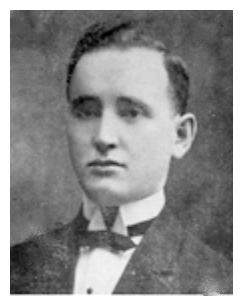
From Radomsk he moved to Częstochowa where he was the manager of the Great Synagogue choir and a high school teacher.
From Częstochowa he moved to Łódź. He conducted over the
Philharmonic and was active in the cultural life of the Jewish community. In
Łódź he composed operettas for which he earned top level
international recognition. Among others, Prof. Zaks composed a cantata for the
poem “Mul HaYeshimon” by A. Schlonsky which was performed by the
Philharmonic on October 28, 1935. Among the soloists were the famous cantor
Moshe Kosvitsky and the singer A. Halman. The cantata included a choir, a
tenor, a baritone and a symphony orchestra.
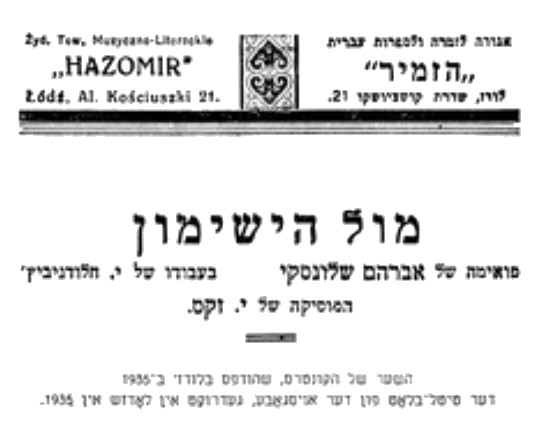 |
| The Cantata of Yitzkhak Zaks to the Poem,
“Mul Hayeshimoon” of Abraham Szlonski |
During WWII Zaks fled to Białystok. There he became the manager of the city radio station. After performing in a musical festival in Moscow he returned to his wife (the daughter of Haim-David Zandberg from Radomsk) and children in Nazi-held Warsaw.
Even in wartime Warsaw he was active in the cultural scene. His name is
mentioned and praised in the “Ringelblum Archive” for his musical
projects during the bitter days of the ghetto Jews. Along with the Warsaw Jews
he was sent to Treblinka where he perished.
The cantata begins in the middle with an introduction by the orchestra, in an adagio tempo. The introduction reflects life in the country. The mood is monotonous and hopeless. Somewhere the lament of the jackals resounds, but the slowly striding caravans in the desert echo. Monotonous Eastern melodies are heard.
Suddenly the mood is disturbed by new, completely unfamiliar motifs. Ships with pioneers arrive; from the ships a happy “ehe-ehe-leile” is carried from the renewers of the old land.
The description is presented by the tenor in recitative form, and later through the men's and women's chorus. The melody gives way to the march of the camel caravan in the country.
The bass gives the announcement: "The dispersed jackals left for the mountain and the king of the animals gave the order, 'Into the desert!'” The whole land is seized by the new flowering life. A hymn resounds. The chorus sings in moderato tempo, then transforms itself into happy folk singing. Clanging is heard, “dli fe, dli fe,” like the work of building, and, at the end again, the pioneers' song “ehe-ehe-leile.” The finale of the hymn is the recitative: “Thus did the hands knead the mixture of cement and sand.”
The mixed chorus and then the women's chorus of three voices and the bass and tenor sing “Al Breva” and “Allegro.” Dissonance is heard, chaos; a three-quarter fugue resounds, a hurricane… A flood…
The tenor brings calm with his recitative. The work again has the upper hand.
The last number from the cantata illustrates the triumph of the work. A chorus of eight voices and soloists sing in a march tempo the hymn of work and repose.
As we have already announced, this year's concert season of Hazamir is beginning, with the cantata of Y. Zaks' “Mul Hayeshimoon” to a text by A. Szlonski. This work will take place under the direction of the composer, Monday, the 28th in the Philharmonia Room.
Taking part in the concert: The mixed Hazamir chorus, Lodz Philharmonia Orchestra and the soloists Aziber Kantor, M. Kusewitski, artist from the Warsaw Opera, A. Helman, H. Fefer and others.
| October 5, 1935) |
by Moishe Zandberg
Yitzhak Zaks was the son of the Radomsker city cantor Reb Solomon Zaks who was
a very talented musician and author of many religious musical productions.
Yitzhak inherited the musical talent from his father and achieved a high level
of musical erudition.
Already in his youth, he distinguished himself in his father's choir, which accompanied the davening in the shul, under the leadership of the director Mr. Gershon Groisberg.
Striving to increase his musical achievements, young Zaks pushed himself to become acquainted with more musical instruments. At the same time, he made an effort to draw in youthful strength in his musical circle, particularly the young, very capable Natan Ofman, who had studied in the Warsaw Conservatory. Together with a great deal of energy, they created a musical circle of young people, who had an inclination toward music, under the name Kultura.
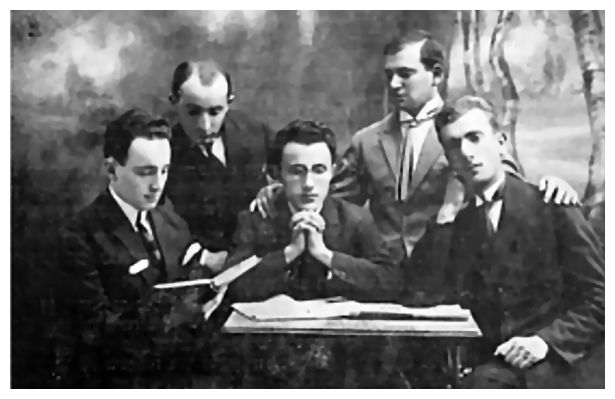 |
| The composer-conductor Yitzhak Zaks (first on the left) and his closet friends
(from the right): Abraham Bugajski, Dovid Fajerman, Berl Bruner, Zisman Epsztajn |
The young Yitzhak Zaks organized a chorus, too, which in a short time, carried out significant
musical productions in public concerts in the city theater. The young conductor
satisfied himself, but not with this. At the end of the First World War, he
already had a dream of creating a Jewish orchestra in Radomsk. As the Austrian
occupation of Radomsk had collapsed, he succeeded in buying up almost the whole
wind-orchestra of the 16th Mountain Troops.
This was not only literally a treasure of first class musical instruments, which made it possible for our musical circle to practice and study, but gave great possibilities to the young gifted musician Mr. Zaks to take advantage of his high qualifications in instrumental music.
After a short education, the orchestra – under the leadership of Mr. Zaks – was already able to give public musical concerts. At the same time, a drama section was created under the leadership of Mr. Adash Horowicz and some times, both cultural institutions appeared together at public events in the city theater, which always were a great spiritual and material success.
In 1919, when the Radomsker Jews could already freely celebrate the Balfour Declaration, the young decided to arrange a public garden entertainment. A large exercise square belonging to the local firemen was located near the city theater, which was also used for public “amusements,” in other words entertainments. After great difficulties, we succeeded in obtaining the square, which was as due decorated. Some blue and white kiosks were set up and at the entrance near the Polish flag, fluttered two blue and white flags, which I myself hung up. The entertainment made a great impression on the local Jewish population, as well as on the Jews from the surrounding towns and shtetlekh, which had sent delegations to the celebration. The friends Natan Ofman and Yitzhak Zaks had furnished sheet music for Yiddish folksongs and other Jewish creations, according to which the firemen's orchestra played during the celebration. For a long time, Jewish Radomsk remembered the beautiful Zionist garden entertainment.
Our musical and drama sections developed more fully and new members joined from the local youth. Public concerts were regularly given, which gave us – Radomsker youth – spirited pleasure. However our happiness did not last long. The Polish population could not accept that the Jews had their own wind orchestra. They requisitioned the instruments from us, with the argument that they belonged to the Austrian army and, therefore, it is war property. Regardless of our interventions, our instruments were never returned to us. Thus, we lost our wind orchestra and its sheet music together with our beautiful young dream.
Mr. Zaks became the conductor of the Czestochowa Synagogue and, later, conductor in the Lodz Synagogue and of Hazamir.
Some of our former members are found in Israel, particularly Mr. Natan Ofman, who sometimes come together in order to remember our Jewish youth in Radomsk.
Let these words be in memory of all of the young friends, some of whom were the
co-founders of the musical and drama sections.
[Page 285]
by Issachar Ben-Abraham
In my house (in Haifa) is kept a picture by the painter Natan Szpigel, who
lived for a long time in Radomsk. The picture is 57 by 79 centimeters, painted
on linen and shows a fragment of the old shul in Kus'mir, which
was destroyed by the Nazi-Germans. In the picture one sees a
hand lamp with four candles, several lecterns and a shelf near the wall.
Natan Szpigel painted many interesting images, but two of his paintings made the greatest impression. One image depicted a pair of worn out, burst leather men's shoes. The shoes were painted in such a way that it appeared as one sees the weary feet of an old man, who went around in them for many years to houses collecting donations. The second picture presented a table with tefillin – a shel-yad (phylacteries for the arm) and a shel-rosh (phylacteries for the forehead). When one studied the tefillin, it appeared as if someone had davened with them and soon someone would again come to the table, take the tefillin and put them on the head and on the left arm to daven.
Natan Szpigel belonged to the Realists. He had exhibitions of his pictures in different art galleries in Poland (in Warsaw, Lemberg) and England (London). In our city, he was the first who had a painting exhibition. The exhibition took place in Zhilinske's Polish gymnazie, on Czenstochower Street. There were landscapes, portraits, still-lifes and all of the paintings made a great impression on the visitors, whether Jewish or Christian.
Little by little, Natan Szpigel was drawn into the communal life of the city, often held lectures about art and associated with the young people. He married the eye doctor [in Radomsk], Hana Fort, who was from Galicia. They lived on Strzalkow Street in the villa of the Jewish pharmacist Mientkewicz and had two children – a boy and a girl.
When the Germans entered the city, Natan Szpigel and his wife decided to stay in Radomsk (He had said: “In a war, no one knows when one will die”). A doctor, a Nazi, came to the city and in a few days, Natan Szpigel received an order from city hall – to immediately free the villa for the German doctor. With a heavy heart, Natan Szpigel's family left the villa and moved into the ghetto in Blumsztajn's house, on Strzalkow Street, which was later the Jewish Hospital.
Natan Szpigel worked for a short time in the special commission of the ghetto at the Judenrat. Later, when he saw the growing and hopeless Jewish need, he quietly left the special commission (“My heart,” he said, “becomes sick and hurts seeing how the Jews come requesting help and one cannot help them”).
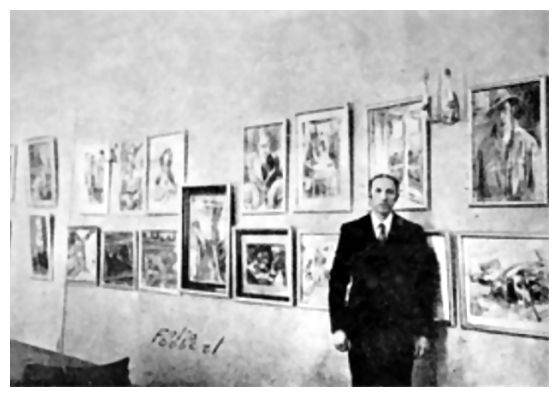 |
| The painter Natan Szpigel during his picture exhibition in Radomsk |
In spite of this, he would often gather the young in the ghetto, talk and sing Yiddish and Hebrew songs,
so that they would not be so sad.
When the Nazis began to prepare the deportations of the Jews, Natan Szpigel left his son in the Polish hospital on Strzalkow Street and hoped that there the child would be protected. However, on the 9th of October 1942, when the Germans chased the Jews from the ghetto onto the deportation platz, two Polish nurses from the hospital came with the boy and left him on the platz.
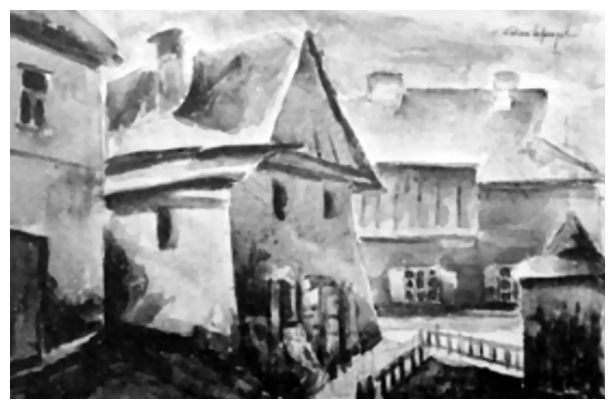 |
| The surviving picture by Natan Szpigel |
A Nazi noticed this. He went over to the boy and roared, “Loifen, du Yude”.
The boy began to run from fear; the German shot after him with his gun and
the boy fell down dead. The Nazi laughed, when he saw the child's blood on the
ground.
After the liberation, when I came by foot from Czenstochow to Radomsk, I met Mrs. Keselman in the market. A few days later, I visited her in her home and there saw two pictures by Natan Szpigel. Mrs. Keselman told me that after the liberation when she came back to her home, she noticed on the wall two portraits of German soldiers. She took them down, studied them from the other side and saw it was splattered with blood. She ran [her fingers] over the pictures. She scratched off the portraits and then the real pictures were revealed-- the two images by Natan Szpigel.
Several days later, when Mrs. Keselman's daughter was by chance standing near the pictures, Polish rowdies shot through the window of the residence and the daughter was murdered. One of these pictures, splattered, subsequently [traveled with me] until I came to Israel.
Natan Szpigel, his wife and the second child were deported from the Radomsker
ghetto and did not come back. One of his images, however, came to Israel, the
land of his young dreams.
[Page 286]
by Josef Sandel
Yakov Cytrinowicz was born in Radomsk in 1893, into the family of a poor
shoemaker. From his youngest years on, he was inspired by the beauty of nature,
but he did not reveal that deep in him there burned a talent for plastic arts.
During the First World War, he was forced to work in a coal mine in Germany, where he took part in the revolution. After many years, he returned to Poland and studied art with Professor Szimanski in Warsaw. There the world-renowned sculptor and “social worker” Nakhum Aronson, of blessed memory, saw Jakov Cytrinowicz's sculptures and praised them. Later Jakov Cytrinowicz came to Paris and at first Bakhum Aronson helped him with “counsel and deed.” In Paris he worked and created many interesting sculptures.
In 1936, the eminent Ukrainian painter Aram Turin wrote about Yakov Cytrinowicz, in “Gszegland Artisticzni ”: “Cytrinowicz goes after simplicity, too. He wins in the fine sculpture 'A Woman in a Long Dress,' but he loses in 'Head of a Girl,' and it a great loss, because in print the head is a very pretty one. The same impression of poverty is felt in the 'Female Body,' with all its virtues and defects of this sculpture, in sum Cytrinowicz is interesting.'
During the Second World War, Yakov Cytrinowicz lived in Paris under Nazi-German occupation. France was divided into two zones: an occupied and an unoccupied. In the summer of 1941, he tried to run away from Paris to the unoccupied zone. Crossing the border he was caught by the Germans; they arrested him and then sent him to a concentration camp from Ban La Roland, there he was spared with a thousand more Jews for almost a year. In June 1942, he was deported to Oswiecim (Auschwitz) to the concentration camp. A month later (July 1942) he died there in the gas chamber.
Honor his memory.(From Josef Sandel's Collection about Yakov Cytrinowicz, in the book “Murdered Jewish Artists in Poland” [Volume two], Warsaw, 1957)
by Melekh Rawicz
Born in Radomsk, Poland; 1900-1918 – Vienna; 1937 – Paris; 1961– Settled in Land of Israel (Safet); died the 4th of March 1963.
There are in every cultural environment artistic people who are, because of a
technical accident of nature, themselves not creative. They are filled with
literature, live their lives with literature. Some write themselves, but in
general not, or scarcely anything. They are full of paintings, dream about
paintings, live their lives with paintings. They understand often better than
the artists themselves, but they do not paint. They are friends of poets,
painters, artists in general – and artists befriend them, dying to hear a good
word from them about their writing, about their painting. They are the
connection between the creator and the beneficiary of all kinds of art from the
nine daughters of Zeus. They are the shadows of the artists, but not a large
shadow – they are colorful, clanging shadows, living shadows who can love.
And A. B. Cerata was one of these.
[Page 287]
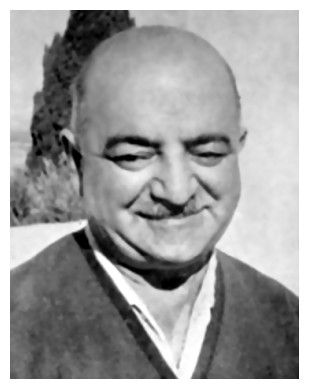 |
| A. B. Cerata |
I knew him in Vienna – when he was only an assistant typesetter in a Jewish
printing shop, right after the First World War, and later we met many times in
Paris. Of average height, with sharp facial lines, Semitic? No – rather
Hindu-Aryan looking. His face always smiled, sometimes with love, sometimes
ironically, sometimes with anger. Often he could be quiet, often observe
endlessly waiting until it was his turn to speak, to approach a painter face to
face, or writer, whom he liked. And he chose his likes according to his taste.
He was a simple worker, a linotypist, a typesetter. Often he worked at night, but he always had time to visit his artist friend. He did everything for others. However, he was not servile; he did not serve. He did things in the manner of a friend. He helped.
In Paris in 1950, later 1956. In a small hotel, I have a plan today to visit the Louvre.
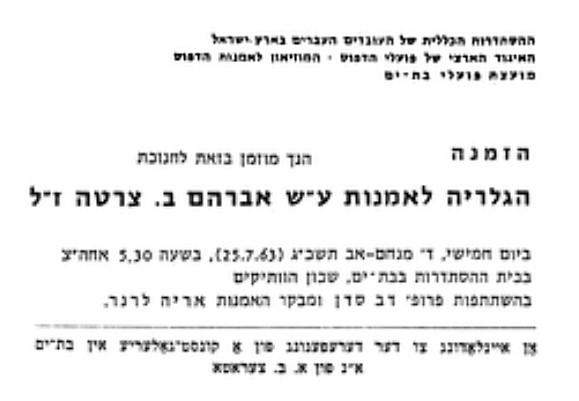 |
| An invitation to the opening of the A. B. Cerata art gallery in Bet-Yam |
I leave the room, begin to ask how to go to the Museum. Suddenly, a smiling face
appears near me, wearing a French beret on the side of the head – Cerata.
– Come Rawicz, come Ruchel, I will take you. But how did your suddenly appear here?
– I heard yesterday by chance that you want to go to the Louvre.
– And so almost every day, these wonderful shadows have some kind of secret power to multiply your time; perhaps that is why they do not connect with families. The artists are their brothers and sisters and children.
In the difficult first Hitler years in Vienna, when it was necessary to save several Yiddish writers from there, Cerata was already in Paris and did everything to save them. And he actually saved them. No one asked him to do this. Letters in my archive pay witness to Cerata's activities.
In order to do something substantial – Cerata, both in Vienna and in Paris, published a line of Yiddish books. The edition was animated with artistic taste by graphic prints. However, Cerata's life's ideal was to create a graphic print museum, mainly Jewish graphics, and to build it in the Land of Israel. And he achieved the building of this museum in Safet – where the first books by Jews were printed by Jews hundreds of years ago.
Cerata had a peculiar handwriting: long straight letters written with the patience of a bee. His letters looked like lines with miniature picket fences. He would describe an event in detail in his letters (8 to 12 sides). They were small short stories in the first person. In these letters lived Cerata's longing to be a writer himself. Through these letters he transformed his beloved writer in an ingenious way into a reader…
Cerata's last letter lays on my table now; in the letter, he writes an awesome story about a miracle with a little goat, who did not want to let himself be slaughtered. Cerata heard the story in Meron, where he spent Lag b'Omer 5722 (1960-61). The whole story is gold with silver from cabala folklore and marvelously illustrated, the little goat with a sky blue skin…
A. B. Cerata was buried in a cemetery in the cabalist city, Safet. Where then
should such the colorful shadows of many Jewish artists and poets find] eternal
rest? Lived as an artist and died as an artist. I am sure that even in death A.
B. Cerata's face has not lost the loving and ironic smile. I am sure that with
this smile he will appear before G-d and before his beloved painters and
poets, who will wait for him in the eternal arts club…
[Page 288]
by H. Leiwik
H. Leiwik, the great Yiddish poet, gave this poem as a gift to the Nowo-Radomsker
landsleit in America. When the poet ran away from Siberia, as a persecuted political
[prisoner], he came to Nowo-Radomsk and found hospitality with contemporary
comrades, A. Alibarde and Zakun Szreiber, who guarded and protected him and
smuggled him over the border on his way to America. This song was published in
the 'Almanac' of the Radomskers in America.
The old-fashioned of the world:
Murder,
Captivity,
Treachery,
Discharge.
Treachery from the closest,
Discharge from the most beloved,
With the back turned away,
With bile on the lips –
Stands the yesterday brother.Thus as it was,
Thus as if nothing had happened
From eternal.And the strongest is after all the person in power,
And the person in power is after all a wicked person,
And the truth is after all with the betrayed,
And not with the betrayer.
And justice is after all the tortured
And not the torturer
Thus as it was,
Thus as if nothing had happened
From eternal.
A dry land on the shoulders
Dirt roads bogged down – through Fifth Avenue,
Frozen lane – between the banks of the Hudson,
Tortured Irkutsk-- through East Broadway,
Shaded yurts – in the snow of Harlem
Through all dirt roads – to the furthest way
Back.
From all truculence to the snow of misery
Back.
All, all, all are driven back.The stronger is after all the person in power,
And the person in power is after all the villain,
And the truth is after all with the beaten,
And not with the beater,
And justice is only with he who is under
Lock,
And not with the guard who bangs with the
Keys.
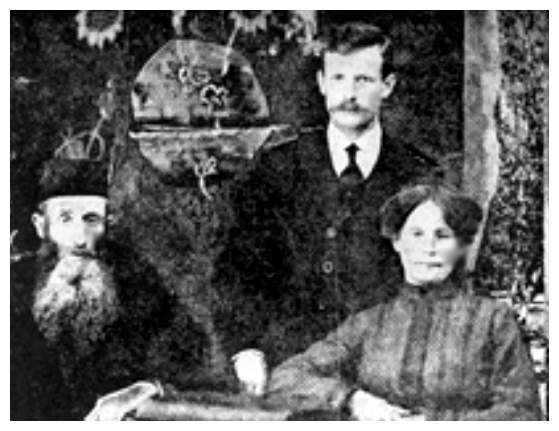 |
| H. Leiwik in the middle (with his parents), on the way from Siberia to America |
Thus as it was,
Thus as if nothing had happened
From eternal.Old-fashioned talk,
Old-fashioned singing, –
Disgrace, shame
To open the eyes on the streets of New York
And see oneself under the watch of sentries
Being led to the old, to the cold
Old-fashioned, eternal land Siberia,
Eternal land of snow.
March.
March.
March.
Gone bright window panes,
Gone warm bed, –
Le no one accompany,
Let no one console,
And the hand of the most loved
Should lower and fall
And not come opposite.
March.
March.
In heavy linen – the body,
In iron blocks – the feet.
|
JewishGen, Inc. makes no representations regarding the accuracy of
the translation. The reader may wish to refer to the original material
for verification.
JewishGen is not responsible for inaccuracies or omissions in the original work and cannot rewrite or edit the text to correct inaccuracies and/or omissions.
Our mission is to produce a translation of the original work and we cannot verify the accuracy of statements or alter facts cited.
 Radomsko, Poland
Radomsko, Poland
 Yizkor Book Project
Yizkor Book Project
 JewishGen Home Page
JewishGen Home Page
Copyright © 1999-2024 by JewishGen, Inc.
Updated 23 Jan 2023 by OR